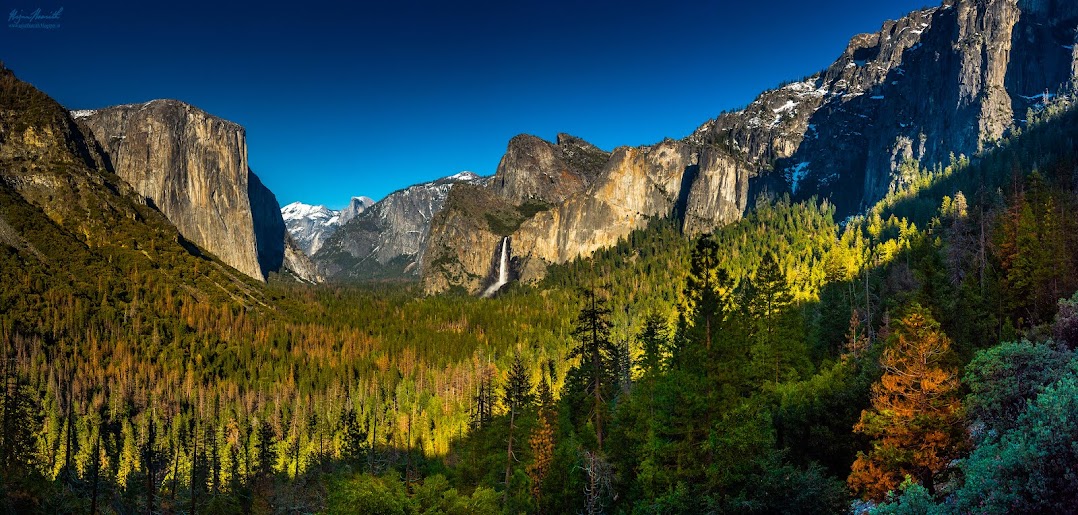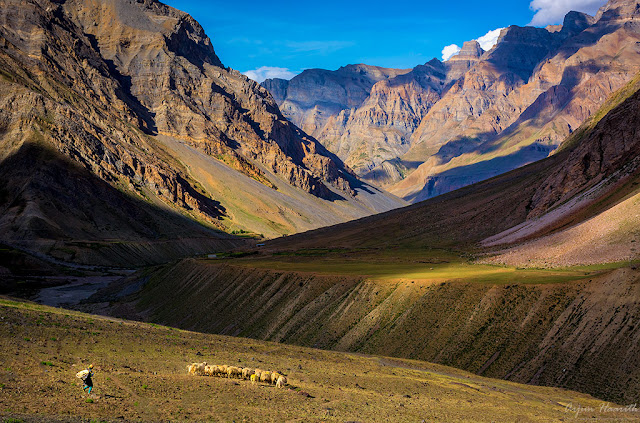(Page 6)
We thought of staying for another day at Mudh. However, considering the odds and risks of mountain roads, we decided to depart from Mudh.
As planned, we departed from Mudh village by 9.30 AM. Our next destination was Tabo, one of the oldest monasteries in the Spiti valley. The drive took almost 3 hours from Mudh to Tabo. The terrain was almost the same as it was from Kaza to Mudh. But after crossing the bridge, the terrain is filled with rocks and pebbles.
Rakeshji was skeptical about driving to Tabo, as the route was not that good as per him. However, the locals suggested us to proceed to Tabo.
Enroute Tabo, we found a herd of Bharals(Blue sheep). These animals were highly camouflaged and that made it very difficult for us to sight them.
The bharal or Himalayan blue sheep or naur (Pseudois nayaur) is a caprid found in the high Himalayas of India, Nepal, Bhutan, Tibet, and Pakistan.
Tabo Monastery
We reached Tabo by 12.30 PM. The old monastery was closed for lunch, and we had to wait until 2 PM for it to reopen.
In the meanwhile, we visited the new monastery and other places surrounding the monastery.
 |
| Satish uncle entering the Tabo monastery |
"Ajanta of the Himalayas", as the Tabo Chos-Khor Monastery is popularly known, was founded more than a millennium back in 996 A.D., The Year of the Fire Ape by the Tibetan Calendar.
It stands on the barren, arid, snow covered, cold and rocky desert of the Tabo valley at a dizzying height of 3050 m. Untouched by the tribulations of humanity, a heaven in its own sense, it has preserved the glorious heritage, traditions and culture of Buddhism through the passage of centuries, withholding its institution with utter purity.
The Tabo Gompa, or Buddhist monastery, is second in importance only to the Tholing Gompa in Tibet in the entire Himalayan region. It was developed as an advanced centre for learning by the great teacher and translator Lotsawa Rinchen Tsang Po, the king of western Himalayan Kingdom of Guge -- also known as Lha Lama Yeshe O'd or Mahaguru Ratnabhadra
The Chos-Khor at Tabo remained one of the most important Buddhist establishments during the time of Lotsawa after the Chos-Khor at Tholing, the capital town of Guge. It is known that the Chos-Khor at Tabo commanded great importance, and hosted for a considerable period, many great scholars and translators in the Buddhist history studies.
 |
| New monastery |
To date, it is the preserver of the Buddhist Legacy and is one of the most important Gompa of the entire Tibetan Buddhist world.
There are small stupa like structures which can be seen around the old monastery which are built by bricks and mud. In the surrounding hills, there are many caves which dates back to ancient times. It is said that many Lamas perform meditation there.
Dhankar Monastery
Our next destination was Dhankar monastery. We had seen this place while going to Mudh. It was nestled on the high cliffs of the Spiti mountains. As and when we went near the place, I was baffled with the amazing architecture it possessed.
Confluence of Parvathi (L) and Spiti (R) rivers
The confluence of the Parvati and Spiti rivers can be seen from Dhankar. Both the rivers emerge from high mountains, and merge together to form Spiti river.
Dhankar village is situated at an elevation of over 3,800 metres in the Spiti Valley. It is connected to the rest of the valley through a motorable road, which is good for small vehicle only.
Dhankar is just like another small village in the cold desert of Spiti Valley. Untouched and away from tourists exploitation , the population of this village is very less
This Monastery was built using traditional materials like mud, stone and timber. It is dark inside and small steps are leading from one place to another. To prevent complete darkness, there are small windows in the walls, from where sunlight approaches. There are many prayer hall inside the monastery.
The cliff base of the monastery is highly vulnerable to erosion caused by the cold wind and incessant rain. This monastery is reducing its stability due to soil erosion and other natural calamities. World Monuments Fund declared this monastery as one of the 100 most endangered sites in the world. A nonprofit group, Dhankar Initiative, is attempting to revoke the loss.
In the recent times, due to the deteriorating condition of this majestic monastery, a new monastery is being built in the village which is very near to the old monastery
Other places of interest in Dhankar are the Dhankar lake and the Dhankar fort. As we were short of time, we could not visit these places.
We then returned back to Kaza via a small village called Shichling. Enroute, we got an opportunity to see another Red fox crossing the road. The road conditions were pretty good, and is well connected from Dhankar to Kaza.
We again checked in to the same hotel we stayed earlier (Hotel Spiti valley) and departed early the next morning back to Manali.
Day 8 - Aug 12th , 2016
Our breakfast was at Losar, which comprised of Alu Paratha and my all time favorite maggi. Myself and Bhargav purchased few shawls from the neighboring shop.
We reached Manali by 5.30 PM after visiting the Beas kund temple at Rohtang pass. The clouds had filled the valley, and this made the visibility very low.
 |
| Manali as seen from a heart shaped cloud |
We then checked in to the same hotel as we stayed on Day 2 ("Hotel Anupam"), and then retired for the day after strolling the Manali mall road.
Day 9 - Aug 13th , 2016
We visited Solang valley and Naggar before departing from Manali.
Solang Valley :
Solang Nala (Valley) derives its name from combination of words Solang (Nearby village) and Nullah (water stream). It is a side valley at the top of the Kullu Valley in Himachal Pradesh, India 14 km northwest of the resort town Manali on the way to Rohtang Pass, and is known for its summer and winter sport conditions.
The sports most commonly offered are parachuting, paragliding, skating and zorbing.
There is a Rohtang tunnel project that is currently going on in the Solang area, which connects you to Rohtang from Solang at a reduced distance.
Mahamaya Jogini falls :
Just 5 kms from the Manali bus station is the famous Jogini falls. It is nestled in thick forests and mountains of Manali. This is a short 1-2 kms trek from the parking area to the base of the falls.
There is a temple that is dedicated to Goddess Mahamaya Jogini (another form of Goddess Parvathi) at the base of the waterfalls. Hence the falls has got its name.
Naggar :
Naggar is a small sleepy hamlet which is close to Manali in the Kullu district of Himachal pradesh. We visited the famous Roerich house there, which contained old artifacts and things used by Roerich. The house contained his paintings and an old vintage car used by him.
We departed Manali by a volvo bus at 5.30 PM, and reached Delhi by 7.30 AM the next day.
Day 10 - Aug 14th , 2016
Spent the whole day in Delhi by visiting Palika bazaar , Connaught place etc.,
Day 11 - Aug 15th , 2016
Took the early morning flight back to Bangalore and reached home by 11.30 AM.
Useful information / Tips to the travelers :
1. Both Dhankar and Tabo has a lot of home stays which range from 300 INR
2. Usually the home stays offer you food (with an additional cost). The food options are limited with just Indian and Chinese dishes.
3. Do not expect luxury here. This place is only for travelers and not for tourists.
4. The best time to visit Tabo and Dhankar is from June to September.
5. The road conditions to Tabo is not good compared to Dhankar. It becomes difficult to visit Tabo if there are frequent rains, as it is prone to landslides.
6. Mobile signals are very weak
7. Electricity is very scarce , so charge your batteries when available.
8. Do not litter the place, keep the Himalayas clean
9. Tabo is around 50 kms from both Mudh and Kaza.
10. The bus connectivity is weak. It is suggested to travel by private vehicles to save time.
Thanks for viewing
This marks the end of my Spiti series
 |
| Pin valley (Page 5) |



























































